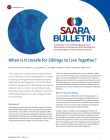"I don’t remember much. I know when me and my brother had time alone we’d be playing in his room and he would proceed to molest me and have me reciprocate back. I had absolutely no idea at the time what was going on, just that I couldn’t tell mom and dad."
- Survivor of sibling sexual abuse, from the SAARA Story Archive
Sibling sexual abuse affects about 2-5% of children and typically starts earlier and lasts longer than other forms of child sexual abuse. The average age of onset for the harmed child is six to nine years, and the average age of the initiating child is 12 to 16 years.
Although a large age difference is sometimes involved, sibling sexual abuse happens even when siblings are close in age. In some cases, there can even be ambiguity about which sibling initiated the sexual behavior, but there may still be harmful impacts.
Any of the following behaviors between siblings are indicators of possible sexual abuse:
- Sexual behaviors that involve physical contact, like fondling, oral-genital contact, or intercourse
- Non-contact behaviors that are not age-appropriate, like the production and sharing of sexual images or spying on a sibling while undressed
- Sexual behavior in the context of a power differential based on age, gender, cognitive or physical ability, social competence, family role (e.g., caregiver), or parental favoritism
- Sexual behavior involving the use of aggression, force, coercion, trickery, bribes, or misrepresentation
- Sexual behavior motivated by an intent to harm, dominate, or humiliate, or by compulsion or pressure from others
- Child feeling ashamed, fearful, angry, anxious, or showing other signs of trauma in the wake of a sexual interaction
Common Responses
Children typically do not disclose their experiences of sibling sexual abuse. They may feel as though they are to blame or participated in some way, or that they will get in trouble if they tell. They may also feel embarrassed, ashamed, or confused about exactly what they experienced.
Some parents who learn of sibling sexual activity may believe it to be “normal curiosity,” especially with children under the age of six. Some individual discussion with each child is useful to find out if they felt pressured, tricked, or uncomfortable. Asking for help or guidance from a pediatrician or child mental health professional is always appropriate.
If parents do believe that one sibling has possibly pressured, manipulated, or harmed another, it is also important not to react with shaming or punishment of either sibling. This can contribute to more distress for the harmed child. What is important is that the harmed child feels supported and protected. It is also crucial to ask the harmed child what they need to feel safe. Parents should check in over time to see if any new concerns or questions have surfaced.
Seeking help for all siblings involved from a medical or behavioral health care professional at the earliest signs of abuse is important in healing and restoring healthy family relationships.
Long-Term Impacts
Research is clear that sexual abuse between siblings can be as harmful as other forms of child sexual abuse. But also like other sexual abuse, when children are supported and have opportunities to process the experience, the harm can be reduced.
When ignored or set aside, sibling sexual abuse can have long-term consequences of shame, alienation, and distrust that lead to family rifts and tension. Seeking the help of a family counselor can be helpful at any stage of life. For those needing help, several therapeutic approaches, including trauma-informed cognitive behavioral therapy and EMDR, have been shown to be effective in childhood and adulthood.










